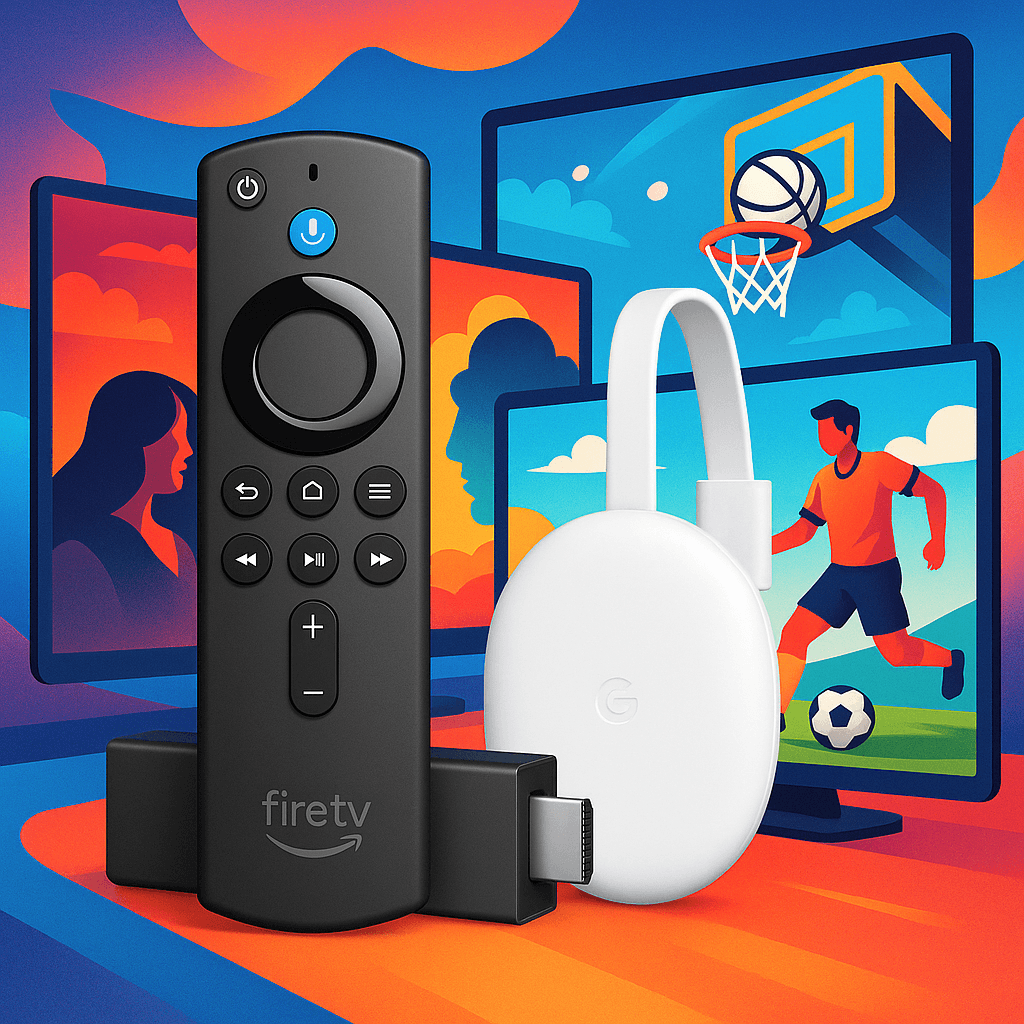
In the modern living room, the battle for supremacy isn’t fought by the television itself, but by the small, unassuming dongle plugged into its HDMI port. This device is the gateway to a universe of content, and choosing the right one dictates not just what you can watch, but the entire quality and feel of your viewing experience. At the forefront of this battle are two titans: Amazon’s Fire TV Stick, the powerful and ubiquitous workhorse, and Google’s Chromecast, the intelligent, content-centric challenger.
On the surface, they appear to be direct competitors offering similar functionality. Both promise to transform any “dumb” TV into a smart entertainment hub, delivering 4K HDR content and a universe of apps at an affordable price.Yet, they are built on fundamentally different philosophies. The Firestick is a direct portal into Amazon’s colossal retail and content empire, a storefront designed to keep you within its ecosystem. The Chromecast with Google TV is an extension of Google’s formidable search and AI capabilities, designed to organize the world’s content and present it to you in the most seamless way possible.
This report serves as the definitive, no-nonsense guide to these two streaming giants. It cuts through the marketing jargon and technical minutiae to declare a winner for the two most demanding use cases: the immersive, high-fidelity world of movie watching and the fast-paced, buffer-intolerant arena of live sports. By the end of this analysis, the best choice for your specific needs will be crystal clear.
At a Glance – Models, Pricing, and the Value Proposition
Before diving into the technical depths, it’s essential to understand the landscape of models and their cost. Both Amazon and Google offer a tiered lineup, including entry-level HD and more powerful 4K versions. For the purposes of a high-quality movie and sports experience, this analysis will focus on the flagship 4K models that truly matter: the Amazon Fire TV Stick 4K Max (2nd Gen) and the Chromecast with Google TV (4K).
The Price War: List vs. Reality
The sticker price of these devices tells only part of the story. The Chromecast with Google TV (4K) typically has a lower recommended retail price (RRP) of around $49.99 in the US and can be found for about £55-£60 in the UK, making it appear to be the more budget-friendly option at first glance. The Fire TV Stick 4K Max (2nd Gen) lists for a slightly higher $59.99 in the US and £69.99 in the UK.
However, the real-world cost is dictated by aggressive and frequent sales events. Amazon, in particular, uses its hardware as a primary gateway to its Prime ecosystem. This means its devices, including the top-tier Fire TV Stick 4K Max, are almost perpetually discounted during major sales like Prime Day, Black Friday, and other seasonal events.During these periods, it’s common to see the 4K Max drop to $35-45 in the US and £40-50 in the UK, often making it the same price or even cheaper than the Chromecast.
This pricing strategy reveals the core business model of each company. Amazon is willing to accept a lower margin, or even a loss, on its hardware to acquire a customer for its highly profitable Prime subscription and retail platform. The Firestick is, in essence, a digital storefront. Google’s approach is also ecosystem-driven, but its hardware pricing has historically been more conventional. For the savvy consumer, this means that a little patience can often secure the more powerful Fire TV Stick 4K Max for the price of its less-specified competitor, making it a superior choice on a pure performance-per-dollar metric.
| Feature | Fire TV Stick 4K Max (2nd Gen) | Chromecast with Google TV (4K) |
| UK RRP | £69.99 | ~£55-£99 (Varies by retailer) |
| US RRP | $59.99 | $49.99 |
| Typical UK Sale Price | ~£40 – £50 | ~£45 – £50 |
| Typical US Sale Price | ~$35 – $45 | ~$40 |
| Overall Value | Often the better value during sales, offering superior hardware for a similar or lower price. | Consistently affordable, but less likely to see deep discounts on its list price. |
Under the Hood – A Head-to-Head Hardware Teardown
While price is a major factor, the internal hardware ultimately determines the speed, stability, and capability of your streaming experience. Here, a clear hierarchy emerges, revealing differing priorities between the two tech giants.
The Engine Room: Processor, RAM, and the Critical Storage Showdown
The performance of a streaming device is dictated by its core components. The Fire TV Stick 4K Max (2nd Gen) is equipped with a faster 2.0GHz quad-core MediaTek processor, compared to the 1.8GHz quad-core Amlogic chip in the Chromecast. While both devices feature a comparable
2GB of RAM for multitasking between apps, the faster processor on the Firestick contributes to a snappier user interface and quicker app loading times.
The most significant hardware difference, and a major victory for Amazon, is storage. The Fire TV Stick 4K Max boasts 16GB of internal storage, double the paltry 8GB found in the Chromecast. This is not a minor specification; it’s a critical quality-of-life feature. Once the operating system takes its share, Chromecast users are left with as little as 5GB of usable space. This leads to the infamous “storage is low” warnings that force users to constantly juggle apps, deleting one to make room for another. For anyone who wants to install a healthy selection of streaming services, sports apps, utility tools like VPNs, and media players, the Chromecast’s limited storage is its Achilles’ heel and a potential deal-breaker. The 16GB on the Firestick provides ample breathing room, eliminating this persistent frustration.
The Connectivity Battle: Wi-Fi, Ports, and Power
For streaming high-resolution 4K content, a stable wireless connection is paramount. The Fire TV Stick 4K Max supports the latest Wi-Fi 6E standard, giving it access to the less-congested 6GHz band. The Chromecast is limited to the older Wi-Fi 5 (802.11ac) standard. In homes with numerous connected devices, Wi-Fi 6E can provide a more stable, higher-speed connection, reducing the likelihood of buffering during a crucial movie scene or live sports match. This is a significant, future-proofing advantage for the Firestick.
In terms of physical ports, the comparison creates a paradox. Google made the modern choice, equipping the Chromecast with a USB-C port for power. Amazon, bafflingly, continues to use the outdated Micro-USB standard on its flagship stick. However, real-world usage reveals a quirk: the Chromecast is often fussier about its power source, frequently refusing to operate from a TV’s built-in USB port and demanding a dedicated wall adapter. The Firestick tends to be more flexible in this regard. Furthermore, Amazon thoughtfully includes an HDMI extender in the box, which is useful for TVs with awkwardly placed ports.
These hardware choices reveal a clear divergence in philosophy. Google prioritized a modern physical connector and a sleeker aesthetic design, evident in the Chromecast’s smooth, puck-like shape and choice of colors. Amazon, in contrast, prioritized raw performance and addressing user pain points. For those focused on the best possible streaming experience, the Firestick’s superior Wi-Fi and doubled storage capacity are far more impactful on daily use than the type of power cable it employs.
The Cinematic Experience – Picture and Sound Quality
For movie lovers, the ultimate test of a streaming device is its ability to deliver a truly cinematic experience at home. This means not only a stunning picture but also immersive, high-fidelity audio.
A Feast for the Eyes: 4K, Dolby Vision, and HDR Support
In the visual department, the two contenders are almost perfectly matched. Both the Fire TV Stick 4K Max and the Chromecast with Google TV (4K) support streaming in 4K resolution at up to 60 frames per second (fps). Crucially, they both offer a comprehensive suite of High Dynamic Range (HDR) formats, including Dolby Vision, HDR10, HDR10+, and HLG. This ensures maximum compatibility with modern 4K TVs, guaranteeing that you’ll get the best possible picture with enhanced contrast and vibrant colors from top-tier services like Netflix, Disney+, and Prime Video.
Independent tests and user feedback confirm that both devices deliver an excellent visual performance, producing sharp, detailed, and color-accurate images with HDR content. For picture quality alone, both are fantastic choices for cinephiles.
The Audiophile’s Verdict: A Clear Winner Emerges
When it comes to audio, a critical distinction separates the two devices, making the choice clear for serious home cinema enthusiasts. For mainstream streaming, both devices are competent, supporting the Dolby Atmos standard for immersive, object-based sound from services that offer it.
The decisive factor lies in their support for local media playback. The Fire TV Stick 4K Max has a massive advantage: it supports HDMI passthrough of advanced, lossless audio codecs like Dolby TrueHD and DTS-HD Master Audio(via its basic profile). The Chromecast
does not support these formats.
This might seem like a niche technical detail, but its implication is profound. These high-resolution audio formats are found on Blu-ray discs and their high-bitrate digital “remux” copies. For the millions of users who maintain personal media libraries on home servers and use apps like Plex or Kodi to stream them, this is a deal-breaking difference. When a Chromecast attempts to play a file with a TrueHD audio track, it cannot pass the signal to the AV receiver. Instead, it forces the Plex server to transcode the audio on the fly, compressing it down to a lower-quality, lossy format like Dolby Digital or even basic stereo. This completely negates the investment in a high-end surround sound system. The Firestick, by contrast, passes the pristine, untouched audio signal directly to the receiver for decoding, preserving the full, dynamic soundscape intended by the filmmakers.
This capability positions the Firestick as a “bridge” device, connecting the modern world of cloud-based streaming with the traditional, high-fidelity realm of home theater. The Chromecast, by omitting this feature, signals that its focus is exclusively on the mainstream streaming ecosystem. For the dedicated movie buff with a personal media collection, the Firestick isn’t just the better option; it’s the only viable one of the two.
The Daily Driver – Interface, Remote, and Ecosystem
Beyond raw specs, the day-to-day experience is shaped by the software interface, the remote control in your hand, and the broader smart home ecosystem. Here, the two devices present a fundamental trade-off between a curated, simple experience and a more flexible, powerful one.
Home Screen Wars: Fire OS vs. Google TV
The home screen is where you live, and the two platforms could not be more different.
- Fire OS (Amazon): The Firestick’s interface is functional and generally responsive but is widely criticized for being heavily ad-centric and aggressively promoting Amazon’s own content. The home screen is often described as cluttered, with large banners advertising Prime Video shows and Freevee content. For users sensitive to advertising, this can feel intrusive. Furthermore, Amazon actively blocks the use of third-party launchers, meaning users are locked into this Amazon-first experience.
- Google TV (Google): In stark contrast, the Google TV interface is widely praised for its clean, content-first approach. Its greatest strength is its aggregation and recommendation engine. It pulls content from all of your subscribed services—Netflix, Disney+, etc.—and presents them together in a single, unified “For You” and “Continue Watching” row. This makes discovering something new a far more neutral and user-friendly experience than on Fire OS. The main drawback reported by some users is that the interface can occasionally feel laggy or stutter, despite the capable hardware.
The Remote Control Duel
The physical remotes also reflect their parent company’s design ethos.
- Firestick (Alexa Voice Remote Enhanced): Amazon provides a more traditional, substantial remote that feels solid and comfortable in the hand. It features dedicated buttons for fast-forward and rewind, a feature notably absent on the Chromecast remote, and typically includes four customizable app shortcut buttons for services like Prime Video, Netflix, and Disney+.
- Chromecast (Voice Remote): Google’s remote is a smaller, sleeker, pebble-like device that is color-matched to the Chromecast itself. While aesthetically pleasing, some users find it a bit small and fiddly. Its major functional omission is the lack of dedicated transport controls (fast-forward/rewind), which can be an annoyance. Its shortcuts are usually pre-assigned to Netflix and YouTube.
The AI Assistants: Alexa vs. Google Assistant
Both remotes integrate powerful voice assistants. The Firestick uses Alexa, while the Chromecast uses Google Assistant. For the core task of finding content—”Show me action movies with Tom Cruise in 4K”—both are exceptionally capable.
- Google Assistant is often considered slightly “smarter” due to its direct integration with Google’s massive Knowledge Graph. It excels at understanding complex, conversational queries and providing richer, more contextual answers.
- Alexa is praised for its sheer number of third-party “skills” and its broader compatibility with smart home devices, making it the leader in home automation.
Ultimately, the choice of assistant often comes down to which smart home ecosystem a user is already invested in.
This fundamental conflict between the two platforms can be seen as one of Flexibility (Firestick) versus Simplicity (Chromecast). Amazon’s device offers more raw power, more storage, and more format support, but it comes at the cost of a cluttered, ad-heavy user interface it forces you to use. Google’s device offers a beautifully simple, clean, and user-friendly interface but compromises on storage and power-user features. The “best” device depends entirely on a user’s technical comfort and which of these compromises they are more willing to make.
| Category | Fire TV Stick 4K Max (2nd Gen) | Chromecast with Google TV (4K) |
| Price | $59.99 / £69.99 (Frequently discounted) | $49.99 / ~£60 (Less frequently discounted) |
| CPU | 2.0GHz Quad-Core | 1.8GHz Quad-Core |
| Storage | 16GB | 8GB |
| RAM | 2GB | 2GB |
| Wi-Fi | Wi-Fi 6E | Wi-Fi 5 |
| Power Port | Micro-USB | USB-C |
| Dolby Vision | Yes | Yes |
| HDR10+ | Yes | Yes |
| Dolby Atmos | Yes | Yes |
| DTS-HD/TrueHD Passthrough | Yes | No |
| Operating System | Fire OS | Google TV (Android 12) |
| UI Focus | Amazon content, ads | Content aggregation, recommendations |
| Casting | Via third-party apps (clunky) | Native Google Cast (seamless) |
| Voice Assistant | Alexa | Google Assistant |
| App Store | Amazon Appstore | Google Play Store |
The Ultimate Sports Stream-Off
For sports fans, a streaming device must meet two key criteria: flawless performance with official broadcast apps and, for many, the flexibility to access content from alternative sources.
The Official Broadcasts: Performance on Key UK Sports Apps
Both platforms provide excellent access to the major UK sports broadcasters. You will find native apps for NOW(which provides access to Sky Sports), TNT Sports (via the Discovery+ app), and DAZN on both the Fire TV Appstore and the Google Play Store.
However, app availability doesn’t always guarantee identical performance. User reports suggest some nuances:
- TNT Sports (Discovery+): Some users have reported stuttering and frame drop issues with the Discovery+ app specifically on Firestick devices, finding the experience on Chromecast or Roku to be smoother.
- DAZN: The DAZN app is often reported to have a superior, faster user interface on the Firestick compared to other platforms. Crucially, it supports high frame rate playback (50/60fps) on Firestick, which is essential for watching fast-moving sports without motion blur.
- F1 TV: The official F1 TV app works well on both platforms. However, for users needing a VPN to access their subscription while traveling, the Firestick is often cited as the easier and more reliable option.
Beyond the Mainstream: Sideloading, IPTV, and the “Dodgy Box” Legacy
The Firestick’s reputation as the king of the “dodgy box” and the preferred device for unofficial IPTV services is well-earned. This dominance stems from its Android-based operating system, Fire OS, which makes it incredibly simple to “sideload” third-party Android applications (APKs) that are not available on the official Amazon Appstore. This is the primary method used to install the vast majority of popular IPTV players and unofficial sports streaming apps.
While the Chromecast with Google TV can also sideload apps, the process is generally considered more complex. The Firestick remains the device with the most community support, tutorials, and documentation in the IPTV world, making it the de facto choice for this grey-area use case. This extends to VPN usage; while both have VPN apps, the Firestick is often seen as the more straightforward platform for setting up a VPN to work with sideloaded applications.
This leads to a simple decision tree for sports fans. If your viewing is limited to official, paid subscriptions, either device will serve you well, with minor performance differences in specific apps. If, however, your sports viewing involves or may involve unofficial IPTV services, the Firestick is currently the only practical choice. It is a dual-purpose device: a mainstream streamer for the family and a powerful, flexible tool for the enthusiast seeking unrestricted access. The Chromecast is, by comparison, a purely mainstream device. This advantage, however, is fragile and depends entirely on Amazon’s continued tolerance of sideloading—a tolerance that is not guaranteed, with rumors of a new, more locked-down OS on the horizon.
The Movie Buff’s Definitive Choice
A movie lover’s needs can be split into two categories: streaming from major services and playing high-quality files from a personal collection. The best device depends entirely on which category is more important.
Streaming Service Excellence
For watching films on mainstream services like Netflix, Prime Video, Disney+, and Apple TV+, both devices offer a superb experience. With full support for 4K, every major HDR format, and Dolby Atmos audio, the picture and sound quality from these apps will be virtually identical and excellent on both platforms. The minor gaps in their app ecosystems—the lack of a native Google Play Movies app on Firestick or an Amazon Music app on Chromecast—are negligible for most users and have workarounds.
The Home Media Server Test: Plex, Kodi, and High-Bitrate Files
This is where the comparison becomes entirely one-sided. As established in the audio section, the Fire TV Stick 4K Max’s support for Dolby TrueHD and DTS-HD passthrough makes it profoundly superior for anyone with a local media server.
For a home cinema hobbyist using Plex, Kodi, or Stremio to watch their library of uncompressed Blu-ray files, the Chromecast is simply not a viable option. It cannot handle the lossless audio tracks, forcing a significant downgrade in sound quality. The Firestick, in delivering that audio untouched to an AV receiver, provides the uncompromised cinematic experience that these users demand. For this type of movie lover—one who values the technology of home cinema as much as the content—the Firestick 4K Max is the only logical choice of the two.
To Cast or Not to Cast
The Chromecast holds one unique and elegant advantage: its native Google Cast functionality. “Casting” content from a phone, tablet, or Chrome browser tab to the TV is a core, seamlessly integrated feature. It is simple, reliable, and a key reason for the platform’s initial popularity. The Firestick can only replicate this feature through third-party apps like AirScreen or the Miracast protocol, which users universally describe as a clunky, less reliable, and often paid-for solution. For users who constantly “throw” content from their personal devices to the big screen, the Chromecast offers a far superior and frictionless experience.
The Final Verdict – Which Streaming Device Is Right for You in 2025?
After an exhaustive analysis, it’s clear there is no single “best” streaming device. The champion depends entirely on the user’s priorities, technical comfort, and viewing habits. The choice between Amazon’s Fire TV Stick 4K Max and Google’s Chromecast with Google TV (4K) is a decision between powerful, flexible, ad-supported hardware and elegant, simple, content-centric software.
Choose the Fire TV Stick 4K Max if…
- You are a home cinema enthusiast with an AV receiver and a local media library. Its exclusive support for lossless audio passthrough (DTS-HD, TrueHD) in apps like Plex and Kodi is a deal-breaker.
- You need the most storage possible for a wide array of apps, games, and downloads, and want to avoid the frustration of “low storage” warnings.
- You demand the best Wi-Fi performance for the most stable 4K streaming, made possible by its Wi-Fi 6E support.
- You are an Amazon Prime member or heavily invested in the Alexa smart home ecosystem.
- You value the flexibility to sideload apps for IPTV or other “grey area” services and are willing to tolerate a more cluttered, ad-heavy interface to gain that freedom.
Choose the Chromecast with Google TV if…
- You prioritize a clean, minimalist, and less ad-heavy user interface above all else.
- You want the best content recommendation engine that intelligently gathers shows and movies from all your services into one convenient location.
- You are deeply integrated into the Google ecosystem, relying on Google Photos, Google Assistant, and Nest smart home devices.
- You frequently cast content from your phone, tablet, or computer and desire a seamless, native, and reliable experience.
- Your viewing is confined to mainstream streaming services, and you do not maintain a personal library of high-bitrate movie files.
The Final Whistle for Sports Fans
For watching official sports broadcasts on apps like NOW, TNT Sports, and DAZN, both devices are highly capable. The Firestick may offer a slightly better UI experience in the DAZN app, while the Chromecast may provide smoother playback on the Discovery+ app. For unofficial IPTV and sideloaded sports apps, the Fire TV Stick 4K Max is the undisputed champion—for now. This recommendation carries the significant caveat that future OS changes from Amazon could eliminate this key advantage.
The Final Scene for Movie Lovers
For those who stream movies exclusively from mainstream services, the choice is a toss-up on picture quality, coming down to a preference for Google’s clean UI versus Amazon’s. For the movie buff who curates and plays their own high-quality movie files from a home server, the Fire TV Stick 4K Max is the only serious choice. Its superior audio format support delivers the true, uncompromised home cinema experience that the Chromecast simply cannot match.
Ultimately, the decision rests with you. By understanding your own needs—be it audio purity, interface cleanliness, casting convenience, or sideloading freedom—the right choice in this streaming showdown becomes clear.



